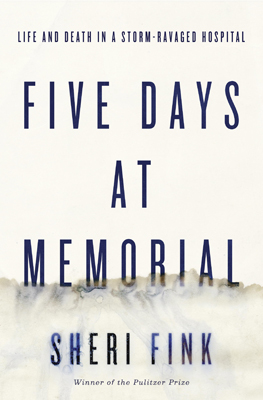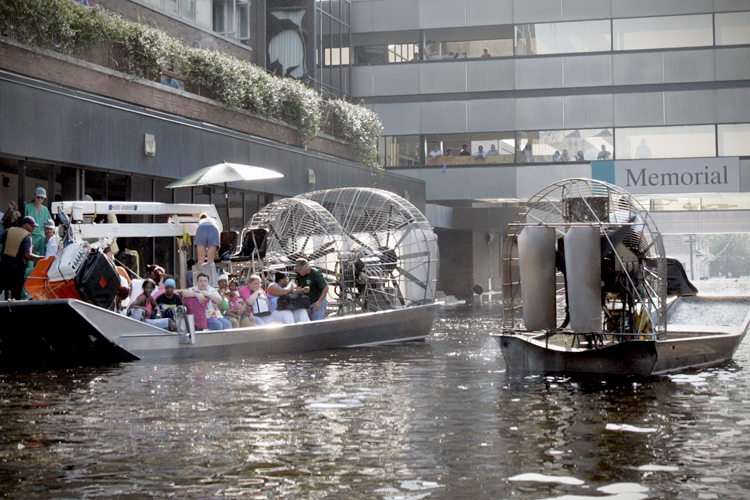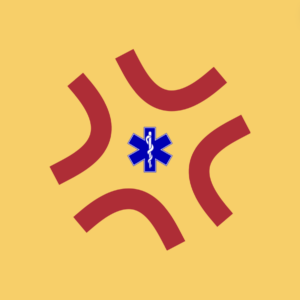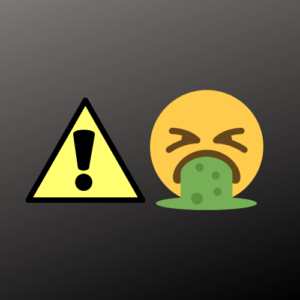by Melody Glenn, MD

It’s a Thursday evening in Oakland, and luckily, the current rain hasn’t gotten in the way of tonight’s book club at Novel Brewing, a book-themed brewery in the heart of the San Pablo corridor. I’m excited that Michael Marsh, a paramedic with decades of disaster and operational experience, and Dr. John Brown, the San Francisco EMS medical director who is also active in our local Disaster Medical Assistance Team (DMAT), will be joining us. Their first-hand perspectives of Katrina will add a more personal touch to the dark drama that Fink so eloquently regales.
In Five Days at Memorial: Life and Death in a Storm Ravaged Hospital, Sheri Fink, an MD-turned-journalist, describes the fate of the patients and staff who faced the storm from within Memorial Hospital’s walls. As the decisions made during this unique, chaotic time cannot be evaluated from the place of our normal lives, she begins her expose by providing a historical and sociological context. When Katrina strikes, she provides a clear timeline of how the social framework and other mores governing our everyday lives start to break down, both inside and outside the hospital. We see how the uncoordinated, ineffective initial disaster response leads to further hopelessness.
Physicians and nurses start to make up their own triage methods, including giving last priority to any patient with a DNR status, irrespective of their current clinical condition. When the first patients are euthanized, Fink almost makes it seem like the only option. Although a reader might think that this situation was a complete anomaly born out of the unique events that occurred at one crazy hospital, Dr. Mary Mercer, the medical director of the San Francisco Base Hospital, adds that the “expectant death” category of triage was being used in many parts of New Orleans. Before Katrina, this category had never before been utilized in the United States; it had never been necessary. The second half of the book follows the legal battles that ensued, seemingly punishing those that had stayed behind to help.

An airboat helped evacuate patients and staff from Memorial Medical Center in New Orleans after Hurricane
Image source: Star Tribune
A few days after Katrina, Dr. John Brown and his DMAT team deployed to the Superdome. Because of safety concerns, they were moved to the airport, where many of Memorial’s evacuated patients and staff had already been waiting for days for food, water, and medical care. A few months later, Mike Marsh and other responders coordinated by the Department of Homeland Security met with Dr. Saussy, New Orleans’ EMS Medical Director, to complete an after action review, the formal evaluation of the strengths and weaknesses of a system and its disaster response. Marsh corroborates Fink’s account, and bolsters it with his EMS perspective. As with other medical infrastructure, the city’s 911 system had collapsed. The city emergency operations center flooded, ambulances flooded, people abandoned posts, the EMS base station was underwater, and a high percentage of the prehospital first responders were unaccounted for.
The federal after action report and media coverage led to several regulatory changes that have positively shaped disaster infrastructure in our country, including a national contract for ground ambulance support, coordination and integration of DMAT teams, the development of mutual aid for law enforcement, and contraflow evacuation methods. Other cities noted the importance of having an agreed-upon triage system in place before a disaster hits, and began to involve community members in the design process.

Unfortunately, these lessons haven’t reached everyone. When reading the after action reports of subsequent disasters, common themes emerge. More recently, when I was providing medical care at Standing Rock during a blizzard in December, I saw more parallels than I would have liked. We also had false information, communication breakdowns, a lack of unified chain of command, unclear triage methods, a patchwork of responders whose actions lacked coordination, and a lack of running water and functioning indoor plumbing. I wished that local leadership had a better understanding of the principles of disaster response, or that they had even read Five Days at Memorial.
After about an hour of conversing about various themes in the book, we noticed the omission of a major one: the mental health of patients, their families, and responders. During the recent Ghost Ship Fire in Oakland, the majority of the county’s response efforts revolved around emergency counseling and psychiatric support for the victims’ family and friends. Dr. Brown said that in all of his DMAT missions, several team members always quit, many never to be heard from again. Marsh told the story of a medic who responded to Katrina. Although she witnessed countless human tragedies during her shifts without apparent difficulty, on her drive home, she would always break down because there, on the side of the road, was always lying the same dead baby. At this point, Kelly Coleman, Alameda County’s Regional Disaster Medical Health Coordinator, mentioned the concept of responder guilt, a type of survivor guilt that first responders often experience. Although I had never before heard the term, it gave a name to an emotion that I knew I had also felt. The pre-planning of disaster preparedness should include the mental health of first responders.

All-too-soon, the clock struck eight, last sips of beer were finished, and plans were made for our next book: Evicted: Poverty and Profit in the American City, which we will be discussing in April. Stay tuned for the scheduled date to join the discussion via twitter.
Do you have any books that you think we should read and discuss? If so, please share by emailing melody.glenn@ucsf.edu

The content of this post is based on the book and group discussion, and not all statements have been independently verified.



